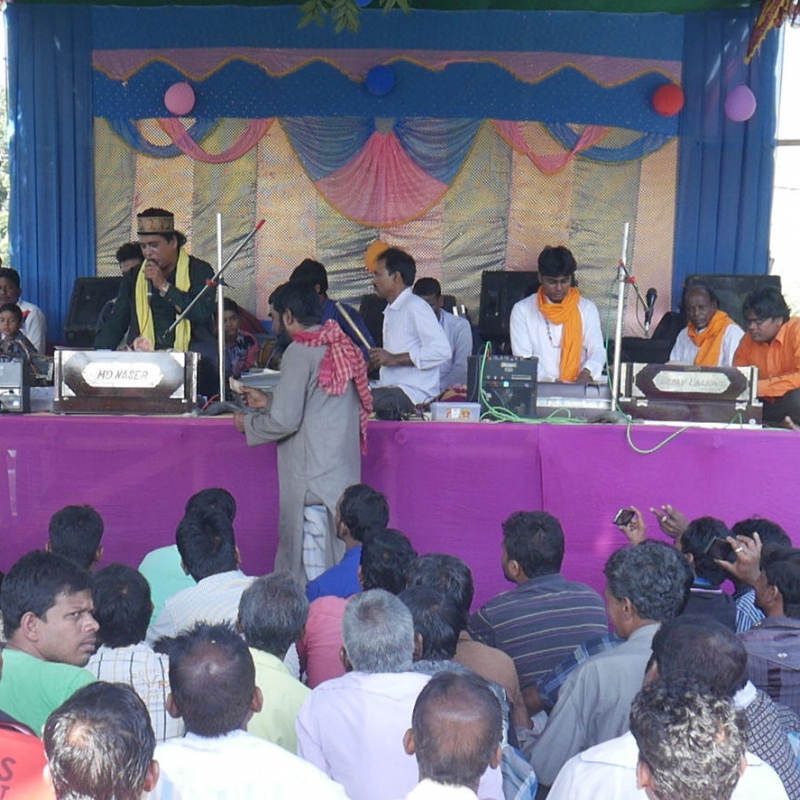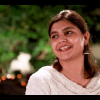Qawwali, as a Sufi musical tradition, has traveled through time and has seen significant changes in terms of space and structure. In the Indian subcontinent four major Sufi Tariqas (orders) have formed a strong base, these are: Chistiya, Qadiriya, Suhrawardiyya and Naqshbandiya. Amongst these four, the Chistiya order has contributed the most to the patronisation and proliferation of qawwali in the subcontinent. As Sufism spread through this region imbibing its local flavours, languages, customs and cultural practices, qawwali too has undergone several changes. One can find Marathi, Dakhini and Bangla qawwali adding to the already existing repertoire of Indic qawwali performances.
The localisation of qawwali language happened during the time of Amir Khusro, the Indo-Persian Sufi poet to whom both khayal and qawwali repertoires owe their structural design and integrity. Khusro, a follower of the Chistiya Tariqa incorporated many local flavours to the qawwali performances. A connoisseur of languages, he has written extensively in Hindvi, Purvi, Brajbhasha and Farsi. Another famous poet-saint Bulleh Shah wrote in Punjabi. In South India qawwali travelled with the Sufi saint Gesudaraz Banda Nawaz. Although the localisation happened in numerous ways, the core of qawwali has remained the same. To understand the core of a qawwali performance one has to ‘listen’ as only through listening one can experience sama, a practice that leads one closer to the divine.
Kenneth S. Avery, in the Introduction to his book A Psychology of Early Sufi Sama: Listening and Altered States recounts a story of Abu'l -Husayn -al Nuri, a Sufi mystic who turned a ‘dry scholarly proceedings’ (in 900 CE), into an ecstatic, frenzied one by reciting ‘four verses of love poetry’ (Avery 2004:1). What the discussions on various doctrines couldnot achieve, his poetry did. All the scholars present there could experience the ‘divine ecstasy’. Such is the power of the occasion of sama to which the roots of the origin of qawwali can be traced.
Sama as a concept means ‘listening’ to the ‘divine message that stirs the heart to seek God’ (Hujwiri 1970:404 cited Qureshi 1986:82). Qawwali has derived its name from Qaul, meaning (in Arabic) the ‘saying’. Qawwali, therefore, as Qureshi opines, is ‘sama realized in practice’ (Qureshi: 82). It is a combination of powerful spiritual poetry and music. The rhythm and the zikr (repetition of chanting of names) further intensify the overall experience of qawwali.
The Sufi dargahs and khanqahs are the traditional spaces where one can hear a qawwali performance. Historically, these Sufi dargahs have provided patronage to the qawwals. During Urs, which is the commemoration of the death of a Sufi saint or his ‘final union with God’, one can experience a qawwali assembly through which a seeker of spiritualism initiates himself to the ‘listening’ practice of sama. Qureshi observes two specific qawwali occasions: ‘Mehfil-e-sama’ or ‘gathering for listening’ and ‘Darbar-e-Auliya’ or ‘the royal Court of Sufi Saints’. The former provides a space and context for the ‘mystical experience’ through music, whereas the latter is an occasion for a Sufi ‘to pursue his personal quest for mystical union (Qureshi: 107).
Qawwali is a musical performance of texts that has to be understood on the basis of its context i.e. the Indo-Pakistani Sufism that has its core entwined with the early Sufi mysticism of the Middle East and Persia. What is sought is the ultimate union with the divine (tawheed) through the awareness and belief in the oneness of God (Wahdat-al-wajood) or that everything is the ‘reflection’ of the divine (Wahdat-al-Shahood). A spiritually inclined man’s journey to become a ‘universal man’ or Al-insan al-kamil has to go through the stages of fana, annihilation of the self. These are: Fana fi Shaykh (annihilation in the being of the Murshid), Fana fi Rasool (annihilation in the being of Rasool) and Fana fi Allah (annihilation in the being of Allah). Then there is a stage of baqa or the stage of permanency. During the practice of sama, poetry ignites this awareness, an experience that can only be defined as ecstasy (wajd). Music here, therefore, reminds one of the melodious voice of the divine.
The vast array of Persian mystic poetry coupled with Hindustani classical music contributed to the making of the qawwali repertoire and the subsequent tradition of the same in the Indian subcontinent. The poetic form of qawwali, as Qureshi has observed, is strophic. Some of the features of qawwali rhyme scheme are qafia or ‘consistent rhyme syllable’ and radif or ‘repeated monorhyme’ (Qureshi: 86). Radif, as can be understood through its definition, is reiterated in the manner of zikr, thus linking the performance directly to the Islamic practice of repeating the names of God. This rhythmic arrangement goes well with the ghazal form, which according to Scimmel could be an ‘ideal vehicle for mystical experience’ (Scimmel 1975:162 cited Qureshi: 86). Khusro’s ghazal opens with matla (the opening couplet) and closes with maqta (the closing verse that often incorporates the takhallus or the signature of the poet).
The qawwali’s contents include (apart from the ghazal form), hamd or the praise of God/Allah, naat or praise of Muhammad, manqabat or praise of Ali and other Sufi saints, munajaat (conversation at night), a form of prayer, marsiya (lamentation for the dead) and kafi or a poem in Punjabi or Sindhi. Traditionally a qawwali performance begins with a hamd, whereas a qaul indicates to either the beginning or the end. Hamd, naat and qaul are the obligatory hymns that have to be included in a typical qawwali performance. Qaul, as Qureshi observes, ‘establishes the principle of spiritual successorship on which the concept of Sufi hierarchy is founded' (Qureshi: 116). Another set of hymns (Rung) are sung in a qawwali assembly to refer to the founding saint of a particular silsilah (order). For example, ‘Aaj Rang’ in which Khusro ecstatically expresses his reverence to his spiritual guide, his master Nizamuddin Aulia.
As mentioned earlier, Indian classical music has contributed to the structural integrity of the traditional qawwali repertoire. A typical qawwali performance begins with alap in a particular dominant raga of the performance. Unlike the Hindustani classical repertoire, qawwali mixes up ragas that are relatable. After the alap a verse or a text is recited, then the main body of the qawwali is demonstrated.
Like Sufism, qawwali is experiential. From a very early age, a disciple is initiated into the listening practice. The training is required only when any sort of correction is needed and when the disciple is ready to learn the Sufi philosophy. Like Hindustani classical music, qawwali follows a strict family-oriented gharana tradition. The performative technicalities are passed down from one generation to the other. The qawwali, especially North Indian and Pakistani qawwali repertoire,can be traced back to Khusro, who taught his disciples the particulars of a qawwali performance and thereby formulated the legendary ‘Qawwal Bachche Ka Gharana’. This gharana is the root of almost every prominent Chistiya qawwali performers of India and Pakistan. Gharana is important for the qawwals as the training of qawwali requires a deep understanding of Sufi philosophy as well as the vast repertoire of mystic poetry.
The Indo-Pakistani qawwali repertoire has a ‘recognised musical identity’ (Qureshi: 19), i.e., the texts are identifiable. These are called Purane dhun / Purani Bandishein or old tunes like ‘Man kunto maula’, then there are ‘Qawwali ke thet dhun’, for example, ‘Kaga sab khaiyo’, or some specific qawwali tune that can be used in a performance with any textual context. Often a qawwal shifts from one text to another and even from one poet to another. Apart from these standard qawwalis, the qawwals have a wide range of contemporary tunes or ‘Aajkal ke dhune’. Also they draw heavily from Sant Kabir, Tulsidas and other proponents of the Bhakti tradition. They also compose new tunes or incorporate some tunes that they have picked up from somewhere; these are called ‘urana’ or snatched tunes.
Conventionally a qawwali performance is a gathering of eleven musicians. For musical accompaniment, sarangi, harmonium, tanpura and esraj are used. Tabla, dholak and pakhawaj are used as rhythm instruments. One specific feature of a qawwali performance is the clapping. The qawwals believe that the body is also a musical instrument and one has to express the beat through the body. There are generally two lead vocalists in a qawwali group. Nowadays one can hear solo performances as well. Although traditionally only men could perform qawwali, female performers too could occasionally be seen performing in a public gathering. Recently in Pakistan three sisters Saba, Fauzia and Zille Huma have formed an all-female qawwali group called Manwa.
The concept of a stage is a modern addition due to the change in the setting of the qawwali performance space. A traditional qawwali performance does not require a separate stage, only a white round sheet indicates the performance space, as could be seen in the Dargahs. The use of amplifiers, an urban stage and a distanced audience have changed the traditional setting of qawwali performance. The proximity of the audience and the performers has also changed with this. Another important feature of qawwali is vel or the showering of cash. In the past vel was the main source of income for the qawwals. With the growing popularity of qawwali as a musical performance, the income is no longer associated with vel, but it is kept as a token of appreciation as well as a traditional qawwali emblem on the urban stage.
The popularity graph of qawwali reached a peak during the early 1950s due to its appropriation into film music and Nusrat Fateh Ali Khan’s unmatched fame as a performer on foreign stages. He rose to prominence at the age of 15 and soon became an international performer. His repertoire relied heavily on the nuances of Indian classical music and attracted audiences all over the world for the trance-like ambience that his performances created. Nusrat Fateh Ali Khan led the way for many musical collaborations and experimentation in his later years.
The setting of qawwali has changed to the extent of experimenting with contemporary fusion music. For example, in Coke Studio Pakistan’s productions one can observe this musical fusion of qawwali and Western music. Qawwals like Abida Parveen, Farid Ayaz and Rahat Fateh Ali Khan have given soulful performances that have presented qawwali in a completely new avatar while retaining the majaz of qawwali intact. Farid Ayaz in his performance of ‘Rang’ has retained the traditional aspects but has experimented with the rhythm structure through the usage of drums and bass guitar. Abida Parveen in her Coke Studio performance of ‘Maula-e-qul’ has experimented with the background score and rhythm.
Although in qawwali, music and religiosity are intertwined, in the modern era performers like the Sabri Brothers, Rahat Fateh Ali Khan have cleverly separated the religious content while retaining some commonly understood concepts that could be interpreted as secular. These secular elements in the Sufi philosophy and qawwali draw in a large audience irrespective of their religious faith not only in the subcontinent but also across the world. The ordinary people, who are not aware of deeply spiritual messages of the qawwalis that are rich in religious idiom, can still relate with the concepts of love, freedom and ecstasy and above all humanity and this bonding or this coming together, the gathering of the masses, is what has made qawwali a unique living performative tradition.
References
Alam, S., & Bhattacharjee, A. 2012. The Origin and Journey of Qawwali: From Sacred Ritual to Entertainment. Journal of Creative Communications, 7 (3).
Avery, Kenneth S. 2004. A Psychology of Early Sufi Sama: Listening and Altered States. New York: State University of New York Press.
Burckhardt, T. 2008. Introduction to Sufi doctrine. World Wisdom, Inc.
Nayyar, Adam. 1988. Origin and History of the Qawwali. Islamabad: Lok Virsa Research Centre.
Qureshi, Regula Burckhardt. 1986. Sufi Music of India and Pakistan: Sound, Context and Meaning in Qawwali. Cambridge: The University Press.













